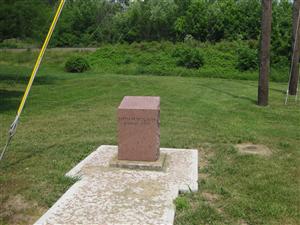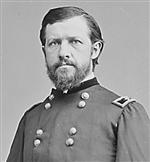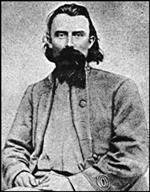Historical Marker: Railroad Depot
Tour Stop
 Directions: The Railroad Depot historical marker [ Waypoint = N37 37.396 W90 38.208 ] is located at the intersection of Walnut and Bogy Streets in Pilot Knob, Missouri, 63663.
Directions: The Railroad Depot historical marker [ Waypoint = N37 37.396 W90 38.208 ] is located at the intersection of Walnut and Bogy Streets in Pilot Knob, Missouri, 63663.
- Return to your car in the Visitor Center parking lot and go straight across Maple Street on Zeigler Street.
- After one block, turn right (east) onto Walnut Street.
- After two blocks, Walnut Street ends at Bogy Street.
- The marker is just across Bogy Street on this side of the railroad tracks.
Description: The text on the historical marker:
Battle of Pilot Knob
Railroad Depot
From 1858 to 1871, Pilot Knob was the terminus of the St. Louis & Iron Mountain Railroad. During the war the supply depot located here supplied Union outposts at Patterson, Centerville, Farmington and Fredericktown. The road to Middlebrook ran alongside the railroad between Cedar and Oak Mountains. Slayback’s Regiment camped near the road on the night of the 27th to guard against any attempts by the Union Army to evacuate the fort and escape by this route.
 In 1864, the Iron Mountain Railroad went from St. Louis to Pilot Knob. You are standing where the Railroad Depot was located at the end of the line in Pilot Knob.
In 1864, the Iron Mountain Railroad went from St. Louis to Pilot Knob. You are standing where the Railroad Depot was located at the end of the line in Pilot Knob.
When Brigadier-General Thomas Ewing, Jr. received credible reports of Confederate forces in Fredericktown, Missouri, he quickly took reinforcements down to Pilot Knob on the Iron Mountain Railroad, arriving around Noon on September 26th. Ewing wrote in his official report: [36]
"At 10 Monday morning I took Companies B, C, D, E, and H, Fourteenth Iowa Infantry, under Captain Campbell, and went to Pilot Knob … The village of Pilot Knob, which is the terminus of the railroad and the depot for supply of the lower outposts, is eighty-six miles south of Saint Louis."
Ewing was under orders from his commanding officer, Major-General William Rosecrans, to evacuate Fort Davidson if he were facing Price's whole army. To determine what the Confederates were up to, Ewing sent out a couple of reconnaissance forces south of Pilot Knob, who ran into a large enemy force. Certain he was facing Sterling Price's entire army, Ewing decided to move excess supplies (“50,000 rations and a large number of quartermaster's stores”) to St. Louis and make a stand at Fort Davidson: [37]
"The advantages of delaying the enemy two or three days in his march northward and of making a stubborn fight before retreating were so great, even though the defense should be unsuccessful and much of the garrison be lost, that I resolved to stand fast and take the chances … I immediately forwarded up the railroad all the quartermaster and commissary stores not needed in the fort, and all the rolling-stock, and started the quartermaster's wagons empty."
Engineer M. Lynch, in charge of the Iron Mountain Railroad train in Pilot Knob, described events in September: [38]
"I had orders from Major Wilson and General Ewing to leave Pilot Knob promptly at eight o'clock [on September 27th] … We left the station at that time … Our orders were to retreat to De Soto, picking up the bridge guards at different bridges. When we stopped at Big River Bridge to pick up the guard there two men in citizens' clothes came riding in hurriedly and loudly warned us to get away as soon as possible as the Confederates were coming to destroy the bridge. We got away in short order, and a mile beyond came to a place where the enemy had captured a Federal wagon-train. The wagons were on fire and the mules were running around the country wild. We finally reached a point one and a half miles south of Mineral Point, where we found the track obstructed, one rail having been pried up with a pole and blocked in that position. It was necessary for the troops (bridge guards) on board to get off in order to repair the track. They were at once fired upon but they drove back the enemy when a section foreman, who was on the train, fixed the track sufficiently for the train to pass over … When we had got half a mile beyond this place, looking back, we saw the track covered with Confederate cavalry, said to be of General Shelby's force … Arriving at Mineral Point, we loaded on board a battery of artillery in about three minutes, and then were off again; but before we were under way the enemy was firing down into the town with artillery … We finally escaped to De Soto, where A. J. Smith's corps was stationed."
 On September 26th, under orders from Price to destroy the Iron Mountain Railroad line, Brigadier-General Jo Shelby took his division towards Irondale, Missouri, about 28 miles northwest of Fredericktown. There they destroyed bridges and railroad tracks as far a Mineral Point, Missouri. Now Shelby moved his force up to Potosi, Missouri. Shelby described these events in his official report: [39]
On September 26th, under orders from Price to destroy the Iron Mountain Railroad line, Brigadier-General Jo Shelby took his division towards Irondale, Missouri, about 28 miles northwest of Fredericktown. There they destroyed bridges and railroad tracks as far a Mineral Point, Missouri. Now Shelby moved his force up to Potosi, Missouri. Shelby described these events in his official report: [39]
"Thus for miles and miles a terrible plowshare ripped up the labor of years, and the red flames licked up the debris, with tanks, depots, trestle-work, cord-wood and telegraph wire and poles. After spending five hours in this labor of destruction I recalled all my detachments and spurred away for Potosi. One hundred and fifty Federals were in fortifications there. My advance charged them into the court-house, gained the buildings commanding it, held them there until the artillery came up, when five rounds brought the white flag, and all their arms, with much ammunition and supplies, fell into our hands. The same work of devastation was visited upon the Potosi branch, and the fine depot with seven cars were destroyed."
